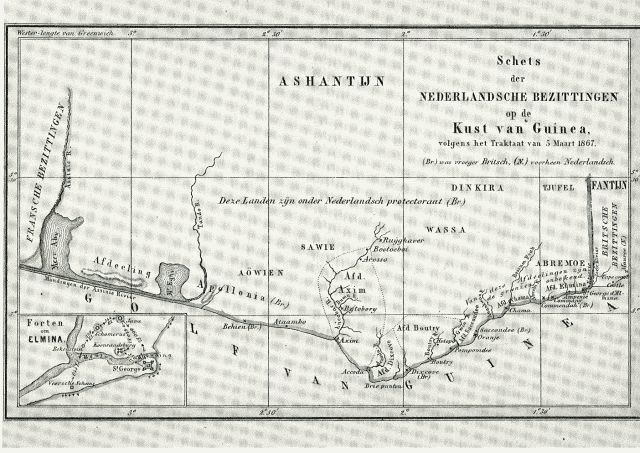Signed 5 March 1867 | ||
 | ||
Parties | ||
The Anglo-Dutch Gold Coast Treaty of 1867 established a trade of forts among the Dutch and British Gold Coast, in order to produce a more coherent area of influence there. All forts to the east of Fort Elmina were awarded to Britain, and all forts to the west were awarded to the Netherlands.
Contents
History
Whereas the Dutch forts on the Gold Coast were a colonial backwater in the 19th century, the British forts were slowly developed into a full colony, especially after Britain took over the Danish Gold Coast in 1850. The presence of Dutch forts in an area that became increasingly influenced by the United Kingdom was deemed undesirable, and in the late 1850s British began pressing for either a buyout of the Dutch forts, or a trade of forts so as to produce more coherent areas of influences.
In the Dutch political landscape of the time, a buyout was not a possibility, so a trade of forts was negotiated. In 1867, the "Convention between Great Britain and the Netherlands for an Interchange of Territory on the Gold Coast of Africa" was signed, in which all Dutch forts to the east of Elmina were handed over to Britain, while the British forts west of Elmina were handed over to the Netherlands.
The trade proved a disaster for the Dutch, as their long-standing alliance with the mighty Ashanti tribe did not fare well with the population around the new forts assigned to them. Shortly after the transfer, the Dutch colonial minister secretly began negotiating a handover of all Dutch forts to Britain. In the Gold Coast Treaty of 1871, the whole colony was ceded to the United Kingdom for 46,939.62 Dutch guilders.
Tariffs
One of the principal reasons for the trade of forts was that a coherent area of influence would allow the collection of customs duties on the Gold Coast. The United Kingdom and the Netherlands committed themselves, by virtue of article 2 of the treaty, to the following tariffs on the Gold Coast:
Signatories
For the Netherlands:
For the United Kingdom:
